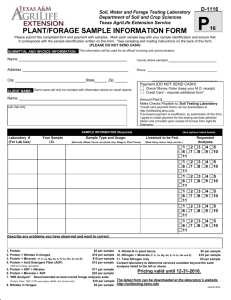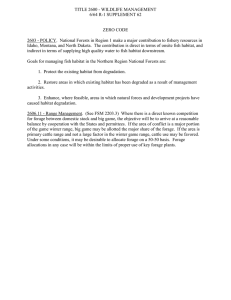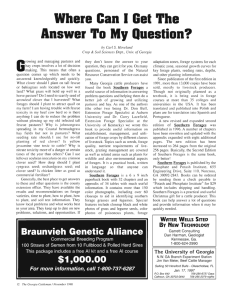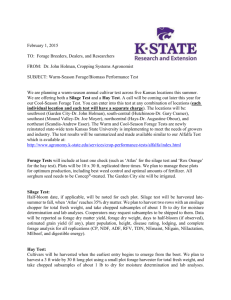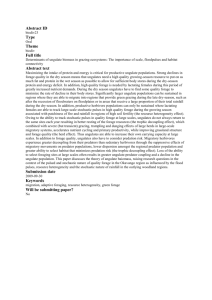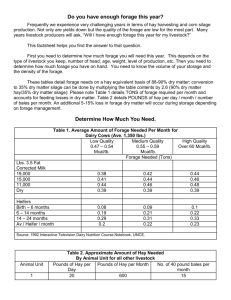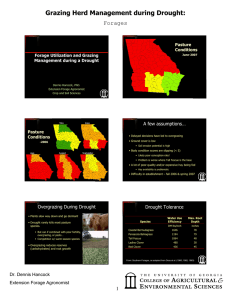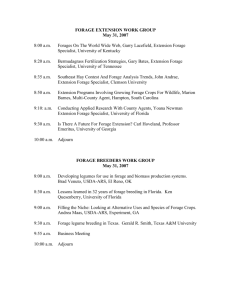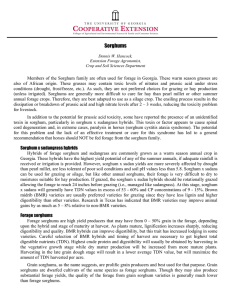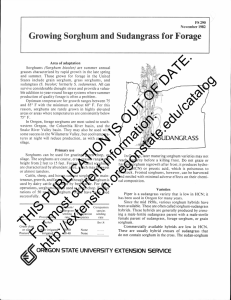Wallace's Farmer, IA 05-21-07 Struggling Alfalfa Fields: Consider Temporary Forage Options
advertisement
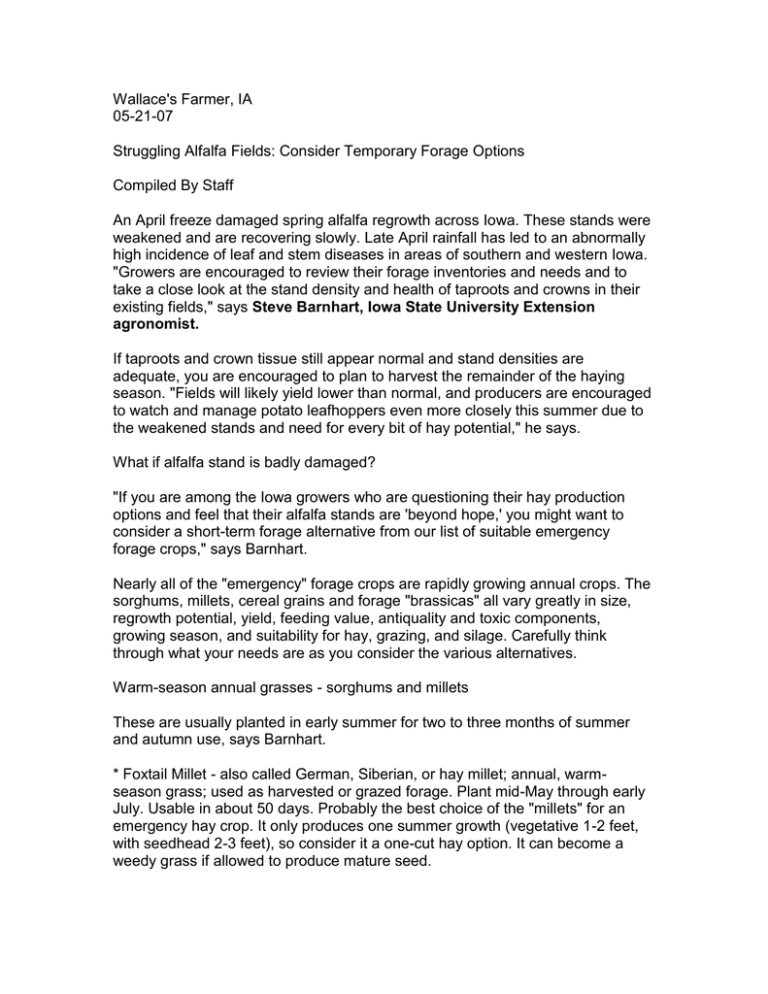
Wallace's Farmer, IA 05-21-07 Struggling Alfalfa Fields: Consider Temporary Forage Options Compiled By Staff An April freeze damaged spring alfalfa regrowth across Iowa. These stands were weakened and are recovering slowly. Late April rainfall has led to an abnormally high incidence of leaf and stem diseases in areas of southern and western Iowa. "Growers are encouraged to review their forage inventories and needs and to take a close look at the stand density and health of taproots and crowns in their existing fields," says Steve Barnhart, Iowa State University Extension agronomist. If taproots and crown tissue still appear normal and stand densities are adequate, you are encouraged to plan to harvest the remainder of the haying season. "Fields will likely yield lower than normal, and producers are encouraged to watch and manage potato leafhoppers even more closely this summer due to the weakened stands and need for every bit of hay potential," he says. What if alfalfa stand is badly damaged? "If you are among the Iowa growers who are questioning their hay production options and feel that their alfalfa stands are 'beyond hope,' you might want to consider a short-term forage alternative from our list of suitable emergency forage crops," says Barnhart. Nearly all of the "emergency" forage crops are rapidly growing annual crops. The sorghums, millets, cereal grains and forage "brassicas" all vary greatly in size, regrowth potential, yield, feeding value, antiquality and toxic components, growing season, and suitability for hay, grazing, and silage. Carefully think through what your needs are as you consider the various alternatives. Warm-season annual grasses - sorghums and millets These are usually planted in early summer for two to three months of summer and autumn use, says Barnhart. * Foxtail Millet - also called German, Siberian, or hay millet; annual, warmseason grass; used as harvested or grazed forage. Plant mid-May through early July. Usable in about 50 days. Probably the best choice of the "millets" for an emergency hay crop. It only produces one summer growth (vegetative 1-2 feet, with seedhead 2-3 feet), so consider it a one-cut hay option. It can become a weedy grass if allowed to produce mature seed. * Sudangrass and Japanese Millet - multiple-cut, warm-season annual; used for fresh cut forage, pasture (rotation grazing is recommended), or silage; difficult to dry thoroughly for hay; varieties vary in height and leafiness. Plant mid-May through early July. First growth usable in about 50 days. Sudangrass has a relatively small hydrocyanic acid poisoning (Prussic acid) risk--avoid pasturing severely drought-stressed or very short (< 12") growth/tiller regrowth. Japanese millet is closely related to the grassy weed barnyard grass, so avoid allowing seed formation. * Hybrid Sorghum x Sudangrass and Hybrid Pearl Millet - multiple-cut, warmseason annual; used for fresh cut forage, pasture (rotation grazing is recommended) or silage; varieties vary greatly in height, leafiness, grain yield depending on the parent lines making up the hybrid. Plant mid-May through early July. First growth usable in about 50 days; regrowth is from tillers; hydrocyanic acid poisoning (Prussic acid) is a risk for hybrid sorghum 3 sudangrass if plants or tillers are cut or grazed at short height (< 24 inches) or from a severely drought-damaged crop. Hybrid pearl millet grows somewhat slower than sorghum 3 sudangrass hybrids and may exhibit poor production in cool summer seasons; no risk of hydrocyanic acid (Prussic acid) poisoning risk with hybrid pearl millet. * Forage Sorghum - tall, one-cut, warm-season annual; used for fresh cut forage or stored as silage; varieties vary greatly in height, sugar content, and grain yield; hydrocyanic acid poisoning (Prussic acid) risk if plants or tillers are cut or grazed at short height (< 30 inches) or from a severely drought-damaged crop. * Grain Sorghum/Forage Soybean Mixture - planted late spring through early summer. Harvestable within about 60 days. Requires good fertilization for production. Harvest at late-vegetative or very early head stage of the sorghum. * Teff or "Summer Lovegrass" - a "possible" for an emergency summer grass hay crop. Teff is an African warm-season annual grass that has grown reasonably well in some Midwest U.S. locations. It establishes relatively quickly; first harvest in 45 to 50 days. Multiple growth cycles through the summer season. Small seeds. Seed sources are limited. Cool-season Annual Grasses - Cereals and Brassicas The following are considered to be cool-season crops. Although they are most often planted in early spring, many of them can be planted in late summer for autumn use, says Barnhart. * Oats and Spring Wheat and Spring Barley for Forage - plant mid- to late summer; cut or graze at late-vegetative through early-milk stage for best feeding value. With advancing seedhead maturity, stems decrease in feeding value greatly. Some wheat and barley varieties produce "beards" (awns) that, when mature, become fibrous and detract greatly from feeding value. * Forage Rape and Forage Turnip - are "brassicas," members of the "mustard family." They are annual, cool-season grazing crop; often normally planted in early spring but can be planted in late summer for autumn grazing. Usable in about 45 days. Forage rape and "Tyfon" (a "leafy top growth" mustard-type crop similar to forage rape) should be grazed rotationally. Forage (bulb) turnips should be "strip grazed" for most efficient use. The forage brassicas require nitrogen for good production. They have been used mostly by sheep producers. * Annual Ryegrass - also called Italian ryegrass; very rapid seedling emergence and growth to seedhead formation; high nutritive quality; does not overwinter in Iowa; if allowed to mature and shatter seed, could grow as volunteer plants in later years; has become an annual grassy weed in small grains in some parts of the country.
